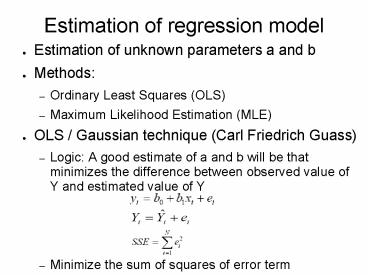Estimation of regression model
1 / 13
Title:
Estimation of regression model
Description:
It tells is what proportion of the variation in Y is explained by the model. ... r2=1-(RSS/TSS) ... ESS can be error sums-of-squares or estimated or explained SSQ. ... –
Number of Views:49
Avg rating:3.0/5.0
Title: Estimation of regression model
1
Estimation of regression model
- Estimation of unknown parameters a and b
- Methods
- Ordinary Least Squares (OLS)
- Maximum Likelihood Estimation (MLE)
- OLS / Gaussian technique (Carl Friedrich Guass)
- Logic A good estimate of a and b will be that
minimizes the difference between observed value
of Y and estimated value of Y - Minimize the sum of squares of error term
2
Error estimation
3
Why squared error?
- Because
- (1) the sum of the errors expressed as deviations
could be zero as it is with standard deviations,
and - (2) some feel that big errors should be more
influential than small errors. - Therefore, we wish to find the values of a and b
that produce the smallest/ minimizes sum of
squared errors - In order to do this, we use calculus minimization
technique. - Take the first derivative and equate it to zero.
- Solve for the unknown. Ensure second derivative
is positive - In this case we must take partial derivatives
since we have two parameters (a b) to worry
about.
4
(No Transcript)
5
- -
- -
6
Properties of OLS estimators
- Point estimators
- SRF passes through sample means of Y and X
- Mean values of estimated and actual Y are equal
- Mean values of residuals is zero
- In deviation form (deviation from mean) SRF is
written without intercept - Residuals are uncorrelated with predicted Y
- Residuals are uncorrelated with X
7
10 Assumptions of OLS method
- In order to make inferences from the estimates we
must make some assumptions in the way Yi was
generated - YiabXiui so assumptions regarding X and u are
critical in interpretation of estimates - Regression model is linear in parameters
- X variable is nonstochastic
- Mean value of disturbance is zero E(ui/Xi)0
- Homoscedasticity of u var(ui/Xi)
- No autocorrelation between error terms
Cov(ui,uj/Xi,Xj)0 - Zero covariance between X and u Cov(ui,Xi)0
8
Assumptions continued..
- No. of observations N must b greater than
parameters to be estimated - Variability essential in X values. Var(X)gt0
- Regression model is correctly specified
- There is no multicollinearity (not applicable in
a two variable model)
9
Precision of the OLS estimates
- Standard errors is a indicator of the precision
and is critical for inference - Given the assumptions SE of B1 and B2 are
10
Gauss Markov theorem
- Given the assumptions of the CLRM, the least
squares estimators in the class of unbiased
linear estimators, have the minimum variance, ie,
they are BLUE (best linear unbiased estimator) - It is linear
- It is unbiased average or expected value of B2
is equal to true value B2 - It has minimum variance and is thus efficient
estimator.
11
Measure of Goodness of Fit
- Since we are interested in how well the model
performs at reducing error, we need to develop a
means of assessing that error reduction. - Total SSExplained SSResidual SS
12
Coefficient of Determination(r2)
- The r2 (or R-square) is also called the
coefficient of determination. - It tells is what proportion of the variation in Y
is explained by the model. - r2 lies between 0 and 1
- Closer to 1, better the model
- An r2 of .95 means that 95 of the variation in Y
is caused by the variation in X - r2 ESS/TSS
- r21-(RSS/TSS)
- The correlation coefficient is the sq root of r2
and ranges between -1.0 and 1.0
13
Sums of Squares Confusion
- Note Occasionally you will run across ESS and
RSS which generate confusion since they can be
used interchangeably. ESS can be error
sums-of-squares or estimated or explained SSQ.
Likewise RSS can be residual SSQ or regression
SSQ. Hence the use of USS for Unexplained SSQ in
this treatment.































